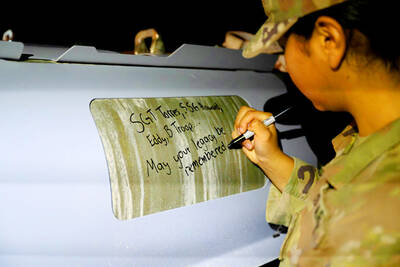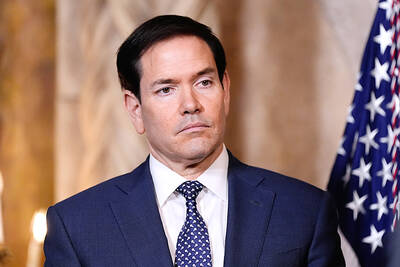Turning heads as they cruise past office buildings and malls, driverless taxis are slowly spreading through Chinese cities, prompting both wariness and wonder.
China’s tech companies and vehicle manufacturers have poured billions of dollars into self-driving technology over the past few years in an effort to catch industry leaders in the US.
Now the central city of Wuhan boasts one of the world’s largest networks of self-driving cars, home to a fleet of more than 500 taxis that can be hailed on an app just like regular rides.

Photo: AFP
At one intersection in an industrial area of Wuhan, AFP reporters saw at least five “robotaxis” passing each other as they navigated regular traffic.
“It looks kind of magical, like a sci-fi movie,” a local surnamed Yang said.
However, not everyone shares Yang’s awe.
Debate around safety was sparked in April when a Huawei-backed Aito car was involved in a fatal accident, with the company saying its automatic braking system failed. A minor collision between a jaywalker and a Wuhan robotaxi last month reignited concerns.
Taxi drivers and workers in traditional ride-hailing companies have also raised fears of being replaced by artificial intelligence, although the technology is far from fully developed.
Wuhan’s driverless cabs are part of tech giant Baidu’s Apollo Go project, which first received licenses to operate in the city in 2022. Initially only five robocars ferried passengers around 13km2of the city of about 14 million.
Baidu said the taxis now operate in a 3,000km2 patch — more than a third of the total land area of Wuhan, including a small part of the city center.
In comparison, US leader Waymo said the largest area it covers is 816km2 in Arizona.
When a car reaches its pickup point, riders scan a QR code with their phones to unlock the vehicle — with the front seats blocked off over safety concerns.
The fares are heavily discounted, with a thirty-minute ride taken by AFP costing just 39 yuan (US$5.40) compared with 64 yuan in a normal taxi.
“They are stealing our rice bowls, so of course we don’t like them,” Wuhan taxi driver Deng Haibing said, using a popular Chinese term for livelihoods.
Deng said he fears robotaxi companies would push traditional drivers out of business with subsidized fares, before raising prices once they achieve domination — similar to the strategy employed by ride-hailing apps in the 2010s.
“Currently the impact isn’t too big because robotaxis aren’t fully popularized and can’t drive everywhere yet,” Deng said.
The robotaxi fleet is a tiny fraction of the tens of thousands of taxis and ride-hailing cars in Wuhan.
Increasingly more Chinese cities are rolling out policies to promote self-driving services though, part of a national push for tech supremacy.
Baidu and domestic rival Pony.ai have for years tested models of varying autonomy levels in industrial parks around the country. Shanghai issued its first batch of provisional permits for fully driverless cars last month, and Beijing has approved fully autonomous robotaxis in suburban areas. The southwest city of Chongqing and southern tech hub of Shenzhen also have pilot projects underway.
Technology wise, there is still a long way to go before self-driving taxis become ubiquitous though, Trivium China tech policy analyst Tom Nunlist said.
“Everybody seems to think autonomous driving is inevitable at this point, and frankly, I don’t know that it is,” he said. “Presently fully autonomous driving tech is simply not ready for large-scale deployment.”
Even in Wuhan’s Apollo Go taxis — which can spot obstacles and wait scrupulously at intersections — ultimate responsibility for safety still lies with human officers monitoring rides remotely. During one ride in an Apollo Go car, one manipulated the car’s built-in touchscreen to remind AFP reporters to put on their seat belts.
“Safety personnel provide strong assurances for your ride via remote 5G assistance technology,” the Apollo Go app tells users.
Robotaxis are also far from able to replicate the human touch.
“Some customers have disabilities and [driverless cars] definitely wouldn’t be able to help them, and some passengers are carrying large items,” ride-hailing driver Zhao said. “Only a human can help.”

REVENGE: Trump said he had the support of the Syrian government for the strikes, which took place in response to an Islamic State attack on US soldiers last week The US launched large-scale airstrikes on more than 70 targets across Syria, the Pentagon said on Friday, fulfilling US President Donald Trump’s vow to strike back after the killing of two US soldiers. “This is not the beginning of a war — it is a declaration of vengeance,” US Secretary of Defense Pete Hegseth wrote on social media. “Today, we hunted and we killed our enemies. Lots of them. And we will continue.” The US Central Command said that fighter jets, attack helicopters and artillery targeted ISIS infrastructure and weapon sites. “All terrorists who are evil enough to attack Americans are hereby warned

Seven wild Asiatic elephants were killed and a calf was injured when a high-speed passenger train collided with a herd crossing the tracks in India’s northeastern state of Assam early yesterday, local authorities said. The train driver spotted the herd of about 100 elephants and used the emergency brakes, but the train still hit some of the animals, Indian Railways spokesman Kapinjal Kishore Sharma told reporters. Five train coaches and the engine derailed following the impact, but there were no human casualties, Sharma said. Veterinarians carried out autopsies on the dead elephants, which were to be buried later in the day. The accident site

‘POLITICAL LOYALTY’: The move breaks with decades of precedent among US administrations, which have tended to leave career ambassadors in their posts US President Donald Trump’s administration has ordered dozens of US ambassadors to step down, people familiar with the matter said, a precedent-breaking recall that would leave embassies abroad without US Senate-confirmed leadership. The envoys, career diplomats who were almost all named to their jobs under former US president Joe Biden, were told over the phone in the past few days they needed to depart in the next few weeks, the people said. They would not be fired, but finding new roles would be a challenge given that many are far along in their careers and opportunities for senior diplomats can

RUSHED: The US pushed for the October deal to be ready for a ceremony with Trump, but sometimes it takes time to create an agreement that can hold, a Thai official said Defense officials from Thailand and Cambodia are to meet tomorrow to discuss the possibility of resuming a ceasefire between the two countries, Thailand’s top diplomat said yesterday, as border fighting entered a third week. A ceasefire agreement in October was rushed to ensure it could be witnessed by US President Donald Trump and lacked sufficient details to ensure the deal to end the armed conflict would hold, Thai Minister of Foreign Affairs Sihasak Phuangketkeow said after an ASEAN foreign ministers’ meeting in Kuala Lumpur. The two countries agreed to hold talks using their General Border Committee, an established bilateral mechanism, with Thailand